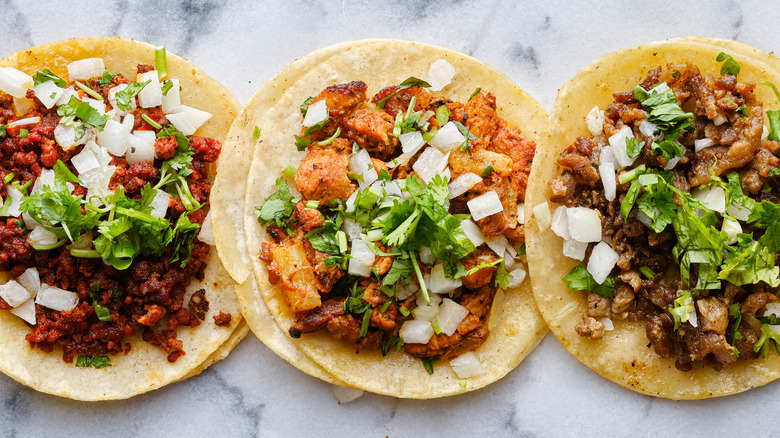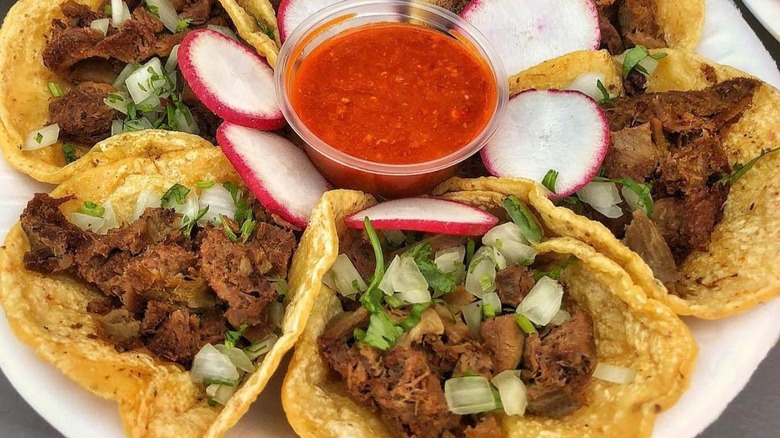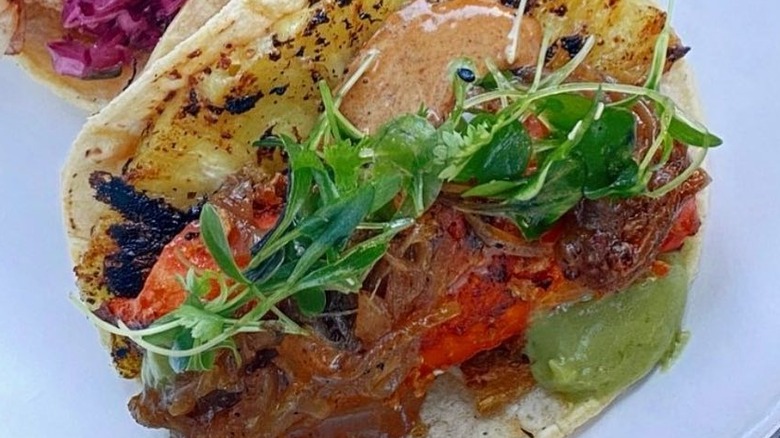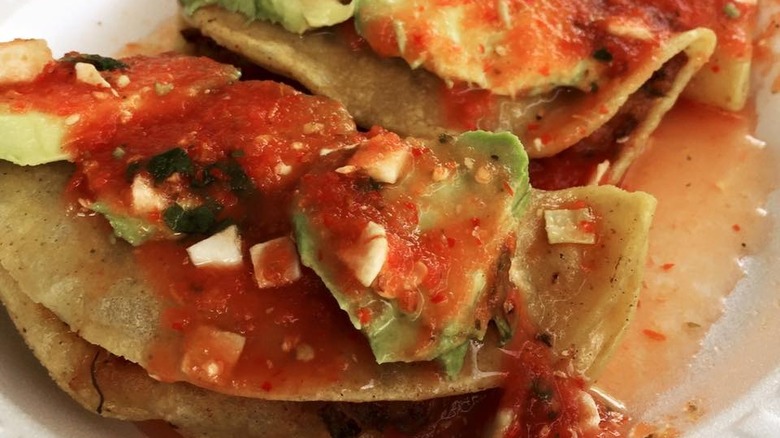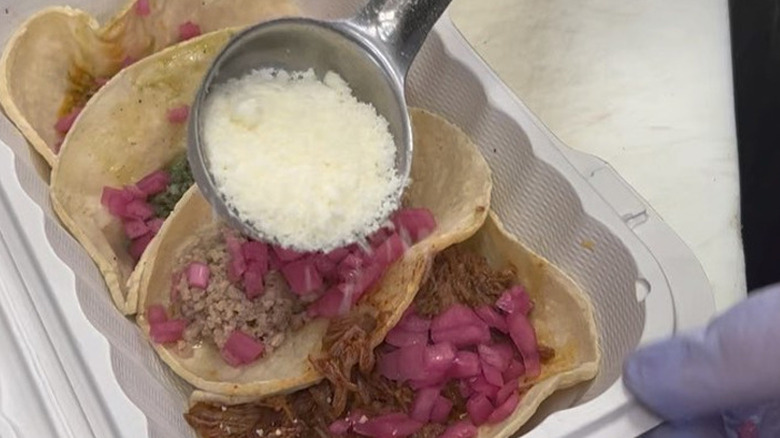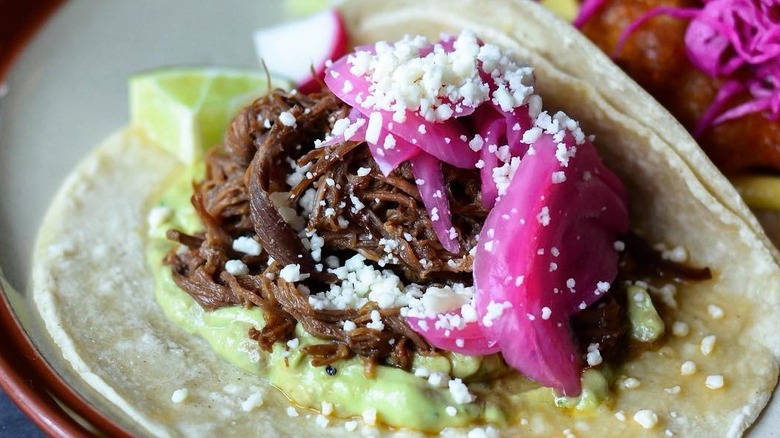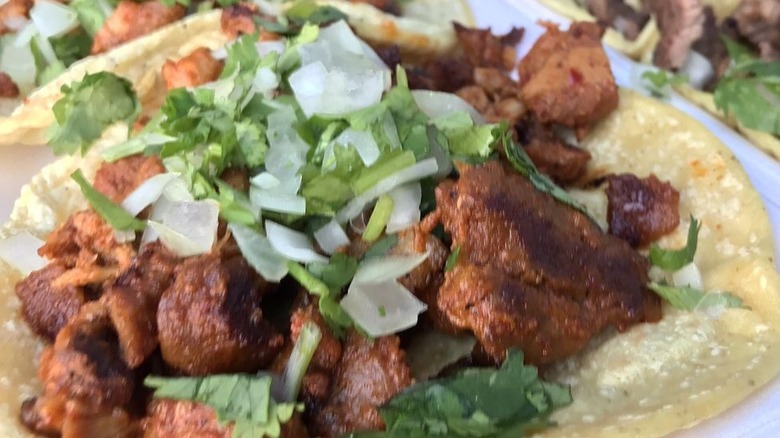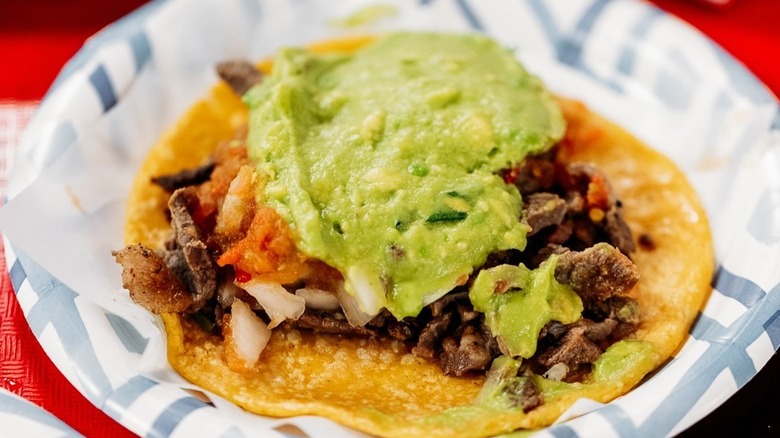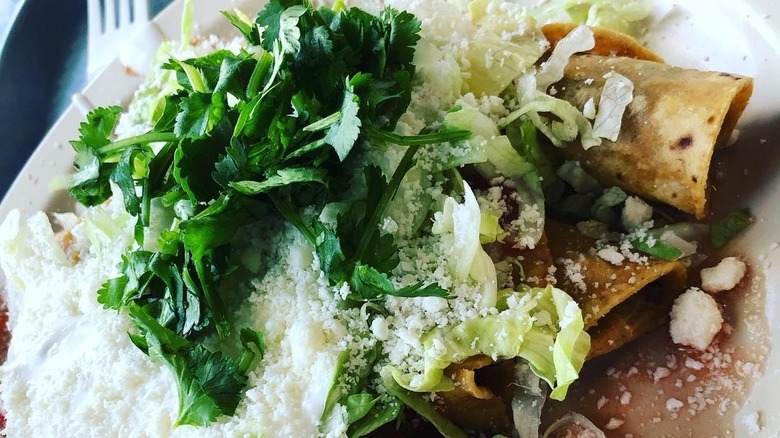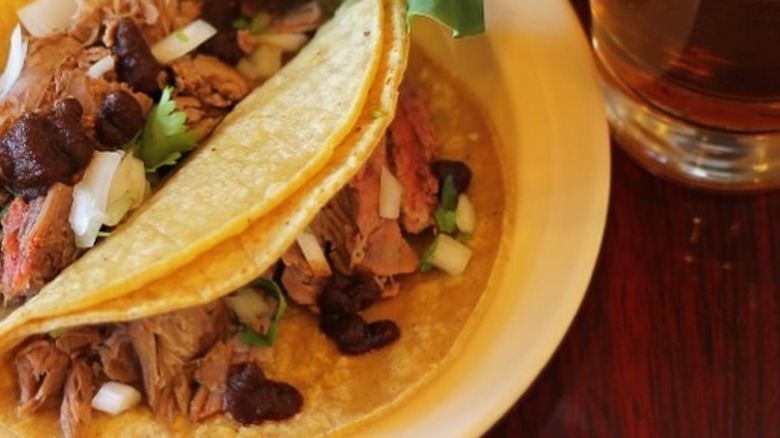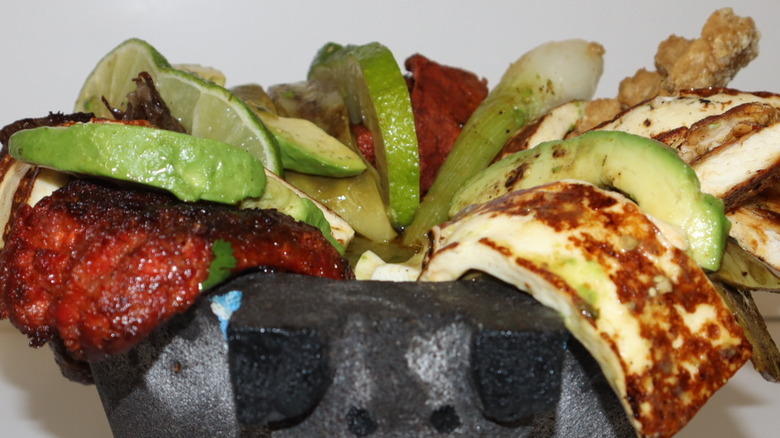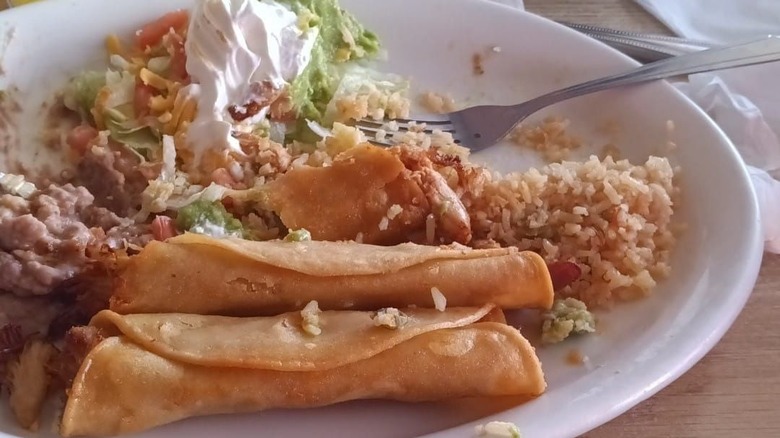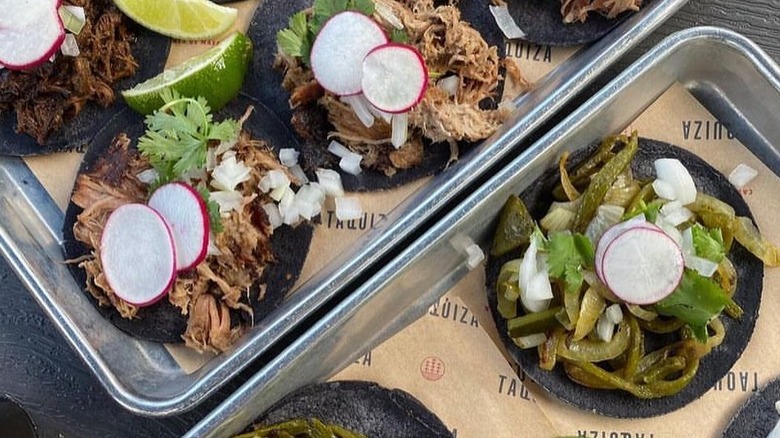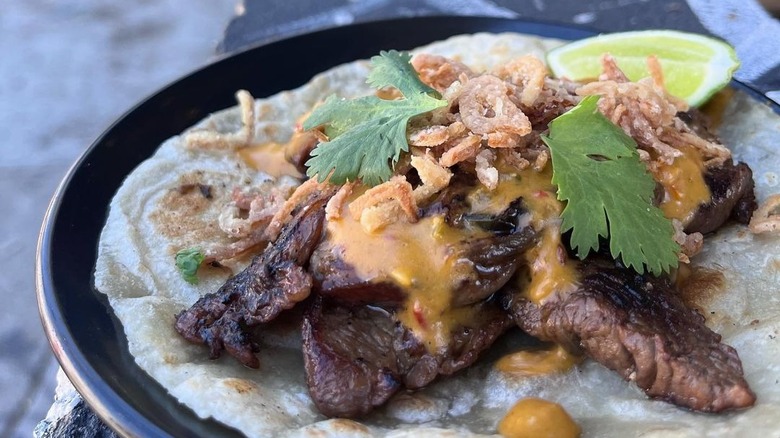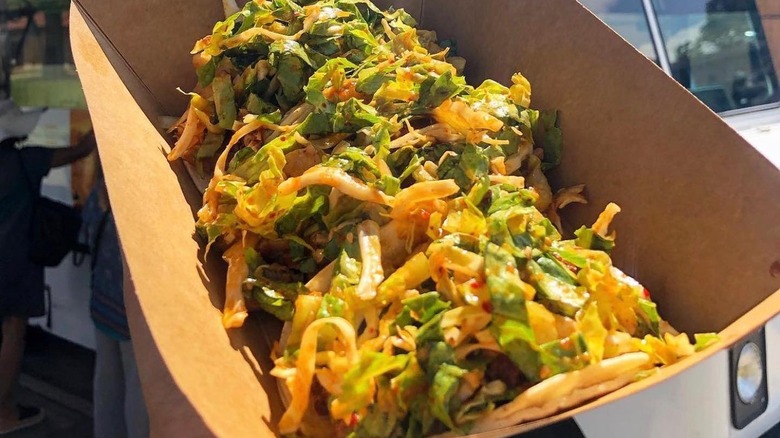The Absolute Best Street Tacos In The US
Since businessman Glen Bell (of Taco Bell fame) remodeled the food for the mainstream American palate, crunchy shells, lettuce, ground beef, and shredded cheddar cheese have become common additions to the taco. But traditional Mexican "street" tacos (or to purists: "tacos") center around a corn tortilla (two of them layered), and a filling, typically a richly-seasoned and marinated meat (often one that the typical U.S. fast food consumer recoils from; tongue, cheeks, and tripe).
The distinctions between the authentic "street" taco and its americanized cousin have grown ever more important to Mexican-American restaurateurs and foodies. Even as chefs have experimented and played with the form, and working people cooking their own staples have adapted to changing locations and conditions, there remains a deep hunger for the "authentic" taco. Big box grocers have even begun catering to the desire, offering their attempts at "street taco kits" for consumers to assemble at home. While "authenticity" is a slippery concept in food, "street taco" has become the common, if contended name popularly used to delineate a "true" taco from those adapted for American mass appeal.
Sifting out the best "street" tacos requires a discerning eye for quality, adherence to traditional ingredients, and that oh-so unquantifiable authenticity. So whether they're transforming or upholding the classic handheld dish, here are the best places from across the U.S. that have built themselves up from the taco's most foundational roots.
Tacos y Birria La Única - Los Angeles
Los Angeles is the premier U.S. city for knockout tacos, to the point that multiple operations exist just to guide visitors through the best of the city's taco offerings. After famously catering for John Legend and Chrissy Teigen, the family-owned Tacos y Birria La Única expanded its operations to two trucks in the Boyle Heights and Mid City neighborhoods of LA (via LA Taco).
The hometown hero is noted for the richness of its consomé, and the knockout quality of its birria. The adobo-marinated and stewed meat is most traditionally made with goat meat, but beef has become the most common substitute in the U.S. thanks to the country's massive cattle industry. A recent craze for good birria forced even El Pollo Loco to offer it for a limited time. La Única of course serves both goat and beef birria, but let's get real: you want authenticity. Go goat. The food truck keeps its tacos simple with onions and cilantro as the only add-ons, but there are plenty of salsas to try, as well as more elaborate fare such as vampiros and quesatacos. Be aware that La Única is a cash-only spot, as per its website.
Simón Mexican Seafood Truck - Silver Lake, California
Chef Francisco Aguilar honed his craft across the spectrum of Mexican cuisine; from the fine dining scene of Oaxaca, to the time-honored family recipes of rural Chiapas (via LA Taco). Now, his royal blue truck Simón is shaking up the LA food scene with rich and often quite experimental seafood offerings.
His recipes typically start with tacos mariscos that are classic staples in Mexico's southwest coastal states, but then veer into flights of culinary fancy. From mixing yellow and blue corn masa to make tie-dye looking tortillas, to remixing the classic al pastor with fish and grilled pineapple, Chef Aguilar isn't afraid to treat his ever-evolving menu like "a playground in my head". Simón does offer a traditional carne asada, which the LA Times suggests makes a perfect base to sample the technicolor house-made salas, including one made from chicharrones. Simón currently resides at the Sunset Triangle Plaza in LA's Silver Lake neighborhood, meaning it's a perfect meal while perusing the nearby farmer's market.
Mariscos Jalisco - Los Angeles
Across its multiple trucks and dine-in locations, Mariscos Jalisco specializes exclusively in seafood, and excels in the art of tacos dorados; tacos whose tortillas are fried into a crispy shell, the original ancestor of all hard-shelled tacos. Like Tacos y Birria La Única, Mariscos Jalisco also received major hype from Chrissy Teigen in 2018, who absolutely had to skip the Oscars and track down the truck after seeing it featured on David Chang's "Ugly Delicious".
While the truck's taco dorado de camarones with shrimp and potato is the most popular, its second most standout offering is the Poseidon: a tostada with shrimp ceviche, avocado, octopus, and red aguachile. If you want to play really fast and loose with the definition of a taco to annoy your friends, order the shrimp, octopus, and cilantro-topped ostiones peinados and argue that the half oyster shell is just as legitimate a taco shell as a big folded Dorito.
The Chori-Man - San Pedro, California
Chorizo is a classic but often-overlooked taco filling. Like the name says, Chori-Man excels in all things chorizo, offering chicken, pork, and vegetarian "soyrizo" variants. The restaurant traces its recipes to Zacatecas, Toluca, and even Argentina, in an option that includes garlic, fennel, and a splash of wine.
However, its most famous option is the Tolucan Green Chorizo, the frequent favorite on taco orders. Speaking of ordering, while you're sure to find chorizo available by the pound or by the burrito on The Chori-Man's website and mobile ordering options, the only way to get a Chori-Man taco currently is to walk in directly, which is about as "street" as it gets for a brick-and-mortar location. Chori-Man also wholesales its product, so there are multiple restaurants in the surrounding area where Chori-Man's famous product can be enjoyed street taco style. And if you're still hungry after a morning order of three or four chorizo tacos, Yelp users rave about Chori-Man's breakfast burritos, especially when filled with maple habanero chorizo.
Lone Star Taco Bar - Cambridge and Allston, Massachusetts
LA may dominate the taco scene (and this list), but that hasn't stopped incredible taquerias from emerging and making a name for themselves everywhere Mexican-Americans have settled in the U.S. New Englanders are happily not left in the lurch when searching for good beef barbacoa on a corn tortilla.
Famously featured on Guy Fieri's "Diners, Drive-Ins, and Dives", Lone Star was founded by a team of SoCal and Texan transplants to the Boston area, who brought top-shelf beef barbacoa to New England, with the classic pickled red onions. Traditionally, barbacoa is made from goat (with beef a popular substitute, like with birria), slow-cooked (with a capital SLOW) in an agave leaf-topped pit dug specifically for the purpose. This cooking method traces its lineage back to the indigenous Taíno people who inhabited the Caribbean before the western world even learned their word "barbaca" and transformed it into the Spanish "barbacoa", and eventually the English "barbecue". Lone Star pays its respects by taking multiple days across marinating, smoking, and braising its beef to achieve barbacoa perfection.
La Fachada - San Diego
San Diego is LA's closest rival in boasting its extensive and expansive taco culture, and in the upper end of the city's Logan Heights neighborhood stands the rustic La Fachada. Looking at La Fachada's Yelp page, the number of five-star reviews is staggering. It's practically revered by locals, and is a popular late night spot thanks to its quite extensive hours (until 3 a.m. on weekdays, open 24/7 on weekends).
It's above all else: authentic, and its adherence to a traditional selection of taco meats reminds you that the taco is a quintessentially working-class food. Made by people who needed a meal that could be easily packed and carried for a day's labor, tacos were originally produced simply for vending out on the street, and under profound pressure to get all the flavor, nutrition, and value out of any ingredients available. Among the more popular U.S. fillings like birria, carne asada, and carnitas, La Fachada offers two staples that more-assimilated U.S. taquerias skip; cabeza and lengua (beef cheeks and beef tongue).
Tacos el Gordo de Tijuana B.C. - San Diego and Las Vegas
Another San Diego staple made good, Tacos el Gordo has expanded from its original location to seven, split between the San Diego and Las Vegas areas. The family-owned and operated company may have started its U.S. operation 1998, but the Rojas family boasts over 40 years in the restaurant trade.
The owners haven't let the success as an American fast food mini-chain steer them away from the fundamentals of Tijuana-style tacos; their salsas and guacamole are still made fresh every day, and their meat options still center the original fundamentals; tripa, cabeza, buche (pork stomach), lengua, and a beef suadero (brisket). The guacamole-lathered carne asada is a popular standout, and their Azteca taco includes grilled cactus, a regional addition that is particularly hard to come by in U.S. taquerias. Tacos el Gordo maintains the practice of serving tacos as a small, inexpensive snack meant to be ordered in multiples to assemble a meal, so feel free to sample from across the menu.
Las Cuatro Milpas - San Diego
If La Fachada is a homey neighborhood haunt, and Tacos el Gordo is the hometown hero, then Las Cuatro Milpas is the elder statesman and local legend of the San Diego taco scene. Situated in San Diego's Barrio Logan, the restaurant has stood in the same location since 1933, and still has lines that regularly reach down the block, and locals still report on Yelp that it's absolutely worth the wait.
Its specialties are the fried tacos, whether served folded as tacos dorados, or rolled before frying, turning the tortillas into a crispy flute-shaped shell. Readers might recognize these by the name "taquito" or "flauta", and considering the Southern California history of the term "taquito", there's no reason to stoop so low as to tell your server at Las Cuatros that you want a "rolled taco." Like a lot of these time-honored, family-owned small operations, Las Cuatro Milpas is cash only, so do come prepared so you don't have to rush to an ATM after your forty-five minute queue.
Aqui es Texcoco - Commerce and Chula Vista, California
Splitting its locations between the U.S.'s two taco Meccas in Los Angeles and San Diego counties, as well as the original Tijuana location, Aqui es Texcoco excels with barbacoa de borrego (lamb barbacoa), and the restaurants' founding family is proud of paying tribute to the history of the underground slow-roasted sheep.
Owned by Francisco "Paco" Perez, who Los Angeles Magazine recognizes as a "second-generation barbacoa master", the restaurant's name proclaims "Here is Texcoco", throwing down the gauntlet that from over 1,700 miles away, Aqui can serve you the same lamb barbacoa you would get in the heart of the central Mexican city. Taste Atlas lists Aqui ex Texcoco as the only U.S. restaurant on their list of best barbacoa spots on the planet. The restaurant's use of the authentic pit-based cooking method was demonstrated by Paco himself in Season 2, Episode 2 of "Bizarre Foods America", and has earned awards and recognition from celebrity chefs and food critics from Andrew Zimmern to Rachel Ray.
San Jeronimo - Staten Island, New York
While Los Angeles and San Diego, cities that were formerly Mexican territory, are the obvious contenders for where to get the best U.S.-based street tacos, it comes as no surprise that Mexican-American communities elsewhere are turning out incredible food.
Over the past 20 years an influx of Mexican immigrants into Staten Island has created a vibrant community with fantastic and authentic Mexican food, no matter what the doubters in 1980s' Pace salsa commercials have to say. Starting as a deli and small grocer, San Jeronimo has expanded to a bakery and a full Mexican restaurant. The tacos section of the menu includes off-the-beaten-path fillings that can occasionally be found at Mexican vendors, but are hard to come by in a U.S. sit-down setting. These include pork suadero (pork belly), tripa (beef tripe), and the vegetarian option of calabaza (zucchini and peppers). For both regional representation and the inclusion of vegetarian options that don't skimp on authenticity, San Jeronimo stands proud.
La Posada - Austin, Texas
Texans seem to have insulated themselves from the street taco craze that has pushed American foodies to seek the most "authentic" fare. Case in point: Austin food critics seem to have a thing for flour tortillas, as evidenced by their frequency on their city's 2015 best tacos roster (via Texas Monthly), a transgression for which we'll have to forgive them.
That said, they do know good lengua de res, and the small La Posada is where they get it. Google users rave about the place, and those local critics praise the marinated beef tongue, which is "braised with onions and tomatoes to a stewlike consistency" and taken to "elite status" by the house red salsa. Despite the restaurant's small size, it boasts an extensive menu which yes, does include the "Americanized" taco platter featuring crunchy corn shell, lettuce, tomato, and shredded cheese toppings, and refried beans as a side, but don't let that steer you off course. Tortilla, lengua, onions, cilantro, and a squeeze of lime are what you're there for.
Taquiza Tacos - Miami
Another star highlighted by "Diners, Drive-Ins, & Dives,"this two-location taqueria honors the taco's history tracing through countless people innovating and improvising based on hard limits applied to their choice of ingredients, and finding culinary gold where we may least expect it.
Taquiza features tortillas made from hand-ground blue corn masa, and the most notorious menu item is the chapulines taco, which features chili-seasoned, fried grasshoppers. Chapulines are known for a distinctive, mild, lightly shrimplike flavor, and are a popular street snack in Oaxaca and Mexico City. Don't let the conspiracy theorists scare you, eating the bugs isn't the way of the techno-dystopian future, it's a salt-of-the-earth tradition from centuries of people living off the land. Eat the bugs, with a spritz of lime juice and a healthy amount of garlic. Or if you look into your heart and find yourself honestly too squeamish, Taquiza also serves a classic lengua, a vegetarian-friendly rajas (roasted poblano peppers), and a Baja-style fried mahi.
Guerilla Tacos - Los Angeles
Founded and owned by chef Wes Avila, Guerilla Tacos began as an illegal food cart, then evolved to a food truck and finally to a hip restaurant in LA's arts district (via NPR). Avila has brought his culinary training from Le Cordon Bleu and vision to blend "high and low" food culture. While Chef Avila has stepped back from daily operations at Guerilla Tacos, his rotating menu remains, with the sweet potato taco, which includes feta cheese and an almond and cashew chile salsa, always staying in season.
Guerilla occupies the "avant-garde" niche in the "street" tacos space, its menu most often beginning with a classic filling such as sweet potato, beef suadero, or Baja fried fish, then adding flavors from far-off corners of the world like the sweet potato's pairing with feta, or introducing rare and authentically-Mexican toppings that the American taqueria space often overlooks, such as pickled chayote, or salsa macha with pepitas (pumpkin seeds).
Kogi BBQ Taco Truck & Catering - Los Angeles
The ultimate fusion of flavors that could have only happened in LA (or during the 2018 World Cup, if there was any recipe-sharing among football fans). Like the Lebanese immigrants who brought shawarma to Mexico and helped birth al pastor, Chef Roy Choi put Korean-style BBQ short rib on a corn tortilla and created a new foundational filling, while helping spark the Los Angeles food truck revolution (via NPR).
With four trucks and a permanent taqueria on the Westside, Kogi has made an institution out of blending Korean and Mexican street food (via The New York Times). From putting kimchi on a quesadilla, to marinating calamari in soy and ginger before placing it on a tortilla with an orange-based salsa, Kogi BBQ finds almost every way to combine iconically Korean and Mexican flavors and ingredients, mingling spices and chilis from both locales in every salsa, slaw, and marinade that goes into the food. For the fusion nuts, Kogi BBQ is for you. Purists may sneer, but give suadero de cerdo al gochujang a chance.
